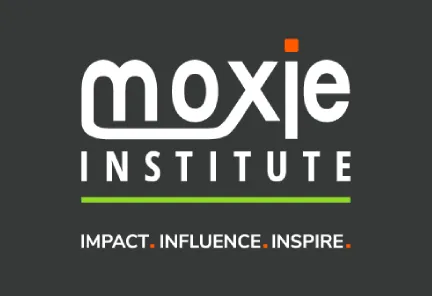Introduction: The Stage is Set for Transformation
Imagine this: You take the stage, and the audience is entranced—not by flashy slides or special effects, but by your mere presence. Your voice reaches the last row effortlessly, your movements are natural but meaningful, and everything you say seems to touch the hearts of the people hearing you. This isn’t a gift you’re born with; it’s the result of using established public speaking techniques derived from the world’s best performers: actors.
At Moxie Institute, we’ve transformed how professionals communicate by cherry-picking the best Broadway and Hollywood techniques. Having worked with Fortune 500 executives and TED speakers, we’ve found that those tools that actors use to hold hundreds of people in rapt attention night after night can also transform you into a captivating speaker, no matter how terrified you might be.
The linkage between performing arts and extraordinary public speaking skills is no accident—it’s science. They both demand the presence to convey real sentiment, hold an audience, and make a real connection. When you learn how to think like an actor, you unlock presentation abilities that you never knew you had.
In this step-by-step guide, we’ll reveal the very acting exercises that have had our clients’ audiences remembering their talks months later. Whether you’re gearing up for a high-pressure boardroom presentation or working to make a career-defining keynote a moment to remember, these performance strategies will help you get past information delivery and into creating experiences.
Why Acting Techniques Revolutionize Public Speaking
The world of the stage has spent centuries developing how we connect to each other and how we feel things. These time-tested techniques are just as effective when it comes to business presentations, helping speakers to do more than inform—they motivate, convince, and change.
The Neuroscience Behind Performance Psychology
The Journal of Neuroscience studies show that when people watch genuine emotions being expressed through acting, their mirror neurons fire, causing true connection and empathy. And this is exactly what great actors—and great speakers—do in their craft.
In our years of coaching thousands of professionals and executives, we have seen that speakers who apply acting techniques experience:
- Better emotional control – This also can help you learn to focus nerves as dynamic energy
- Better vocal control – Practicing vocal exercises and voice production in theater provides range, clarity, and projection
- Increased physical awareness – Principles of stage movement develop a strong presence
- Get in character for real – Method acting methods enable you to deliver your message authentically
Performance Psychology Insight: Acting methods are effective because they use your entire self—body, mind, and emotion—and not just intellectual preparation. This comprehensive system facilitates the magnetic presence that turns ho-hum presentations into unforgettable experiences.
From Stage Fright to Stage Presence
Perhaps the most potent of the gifts that training for the theater gives is that of reseeing the performer’s bond with the audience. Though many speakers perceive their audience as judges to dread, actors consider them partners in a collaboration that involves producing a collective experience.
In our work with executives who’ve overcome serious speaking fears, we’ve learned that assuming an actor’s mindset turns presentation fear into performance energy. This transformation occurs when you understand that, like an actor, your task is not to be flawless; it’s to be present, to be real, and to be connected to your material and your audience.
Try This Theater Exercise: Before your next presentation, set aside five minutes to be “the expert who really likes to help.” Observe how this role-playing alters your posture, breath, and even your relationship with what you are delivering. A lot of the people we work with notice that simply making a change like this reduces their speaking fear by 80 percent.
What Are the Core Acting Techniques for Presenters?
The types of acting techniques most helpful to speechmakers center upon three basic elements: genuine emotional connection, vocal finesse, and powerful physical presence. They are the building blocks of a great presentation performance.
Method Acting for Authentic Connection
Method acting, which seeks authentic emotional truth in performance, was developed by Constantin Stanislavski and popularized by teachers like Lee Strasberg. For speakers, it means finding real human connections to the subject you’re covering.
The Technique of Emotional Truth:
- Identify your genuine stake – What do you care about regarding your subject?
- Tap into universal feelings – How does what you’re saying translate to experiences we all have?
- Discover why your character is doing this – Why are you telling this to them?
- Feel the feeling – Act from the heart
We worked with a Fortune 100 CEO who was about to announce company-wide layoffs, and we used method acting techniques to help him embody his true concern for the employees who would be affected. Instead of delivering corporate talking points, he struck an emotional chord, describing the decision as an excruciating one and committing to support departing team members. The outcome was one of the best-received difficult communications that the company has ever sent.
Pro Insight: Authenticity has little to do with sharing every detail of your personal life—it’s about discovering what in your content touches a real emotional nerve and speaking from a place of truth rather than simply delivering data.
Voice and Vocal Variety Mastery
Actors work for years honing vocal instruments that can fill theaters and communicate subtle emotion. These methods will also liven up any dry presentation.
Essential Vocal Acting Techniques:
- Breath Support and Projection
- Sustain power with diaphragmatic breathing
- Project from within, not from your throat
- Practice talking to the back row without yelling
- Pace and Rhythm Variation
- Increase your speed with something more interesting to energize yourself
- Slow down for emphasis and say something really important
- Employ the pause for dramatic effect
- Tonal Range and Inflection
- Keep up and down the pitch so you’re not overly monotone
- Employ up-talk for questions and engagement
- Lower your voice for authority and emphasis
- Emotional Coloring
- Match your voice tone to the emotional register of your message
- Get comfortable expressing enthusiasm, worry, assurance, and care through voice alone
- Adjust your vocal texture to be intimate or urgent as appropriate
In our public speaking training programs, for instance, we make executives deliver the same content with a different emotional intent—as though you’re talking to children vs. peers vs. superiors. This exercise supercharges your vocal range, but above all, it helps you find the right pitch for every speech!
Quick Vocal Warm-Up: Two minutes of lip trills, tongue twisters, and range exercises before you speak. It’s the equivalent of stretching your vocal cords when you’re an actor getting ready for a show.
Physical Presence and Movement
Stage movement isn’t about dancing, per se, but about fully integrating your body and whatever it does in order to bolster, enhance, and communicate your message. The best actors know the body often speaks louder than words.
Theatrical Movement Principles for Speakers:
- Grounding and Centering
- Take feet apart hip-width for better balance
- Balance your weight on both your feet
- Core can respond for better posture
- Purposeful Gesture
- Gesture in the service of your argument rather than distracting from it
- Work on gestures that complement your natural rhythm of speech
- Shrink or enlarge gesture size according to space and audience size
- Spatial Awareness
- This means moving with purpose, not nervous energy
- Take up all the stage space for interest
- Steps forward for intimacy, steps back for distance
- Eye Contact and Connection
- Connect with people, not the audience
- Employ the “lighthouse technique”—reaching out to various audience sections methodically
- Keep eye contact for the duration of a thought
Movement Integration Exercise: While you are delivering your speech, keep moving around the room, so as to let your body behave naturally in response to your content. Observe which ones feel natural and which ones feel like you’re trying to force them. This allows you to find your true physical speaking style.
How Do You Build Compelling Characters in Your Presentations?
Every good actor invents a character that has certain qualities, motives, and quirks. In much the same way, confident presenters have a speaker persona that doesn’t necessarily change who they are, but ensures their message and the people involved are both ideally matched.
Developing Your Speaker Persona
The speaker’s identity is not a fake character—it’s the closest you can get to the best version of yourself in that given moment, for that specific presentation. It’s like emphasizing some things about your personality and downplaying other things.
Character Development Process:
- Audience Analysis
- To whom are you speaking, and what do they need from you?
- What will be your tone and energy level that will work best for them?
- What level of formality or informality should your online persona have?
- Message Alignment
- Which personality traits help your content the most?
- Are you the supportive guide, the creative thinker, or the authority figure?
- How can your innate personality increase the impact of your message?
- Authentic Amplification
- Determine your actual strengths as a communicator
- Practice daring to exaggerate these dynamic traits without coming off as fake
- Create the parts of your show that get you remembered
One technology executive we coached was a lifelong analyzer and detail maestro whose personal delivery did not translate well into inspiring his team. We also worked with him to create a speaker persona that didn’t compromise his analytical credibility but would allow him to be excited about innovation for real. By tapping into his “passionate scientist” within, he turned team meetings from dumps of data into vision-inspiring strategizing sessions.
Emotional Range and Authenticity
It takes many years of practice for actors to bring out and feel the full gamut of emotions on demand. This doesn’t mean getting theatrical as a speaker—it means having the ability to express the emotions your message calls for in an authentic way.
Emotional Accessibility Techniques:
- Emotional Memory
- Connect your content to the times that you have felt such emotions
- Think of your life experiences for real emotion
- Practice responding to these feelings and expressing them appropriately
- Physical Embodiment
- Pay attention to how different emotions make you stand and breathe
- Practice communicating confidence, concern, enthusiasm, and empathy with your body
- Create an emotional state from a physical one
- Vocal Expression
- Learn to express feelings in the tone and rhythm of your voice
- Repeat the same content with various kinds of emotional stance
- Attain increased sensitivity to the impact of emotions on vocal quality
Essential Insight: Authentic speaking doesn’t mean you need to expose your darkest secrets; it means you need to feel and unleash your emotions that will tell your message and connect with your audience.
Advanced Storytelling Through Performance

After all, acting is, at its core, storytelling, and the tools a good actor employs can help you move your speaking from informative to unforgettable.
Scene Work and Narrative Arc
A good story always has structure that encourages emotional investment and resolution. Actors learn to recognize and translate those story elements, which apply directly to presentation storytelling.
Theatrical Story Structure for Presentations:
- Setup and Character Introduction
- Set the stage and introduce the major “players”
- Develop suspense and an emotional connection to the prediction
- Create clear stakes for what comes next
- Rising Action and Conflict
- Create conflict through problems or barriers
- Employ pace and vocal energy to drive interest
- Make the audience feel the pain or issue
- Climax and Revelation
- State the main insight or turning point
- Apply physical and vocal emphasis for greater effect
- Establish a time of transformation or epiphany
- Resolution and Lesson
- Show how the problem gets worked out
- Connect the story back to your overall point
- Ensure that the audience walks away with specific takeaways
In our storytelling training programs, we train leaders to treat case studies and examples like mini-movies. Rather than just reciting cold, hard facts, your employees learn how to create a cast of characters your audience cares about, create tension around the business issue, and deliver a satisfying resolution that enlightens the key principle.
Creating Vivid Mental Images
Actors are very good at helping audiences see, hear, and feel things that aren’t physically there on stage. This ability—this creating of strong mental images—is the single greatest way to make presentations stick.
Sensory Storytelling Techniques:
- Visual Details
- Curb the use of vagueness and abstracts
- Create visual imagery with the help of your words that the audience may see
- Include color, size, and arrangement
- Auditory Elements
- Put in sound, voices, and atmosphere into your stories
- Use a change of pace in your delivery for different characters and moods
- Keep your language musical and rhythmic
- Kinesthetic Sensations
- Help audiences sense temperature, texture, movement, and physical sensations
- Make gestures that reinforce sensory language
- Tie emotions to body sensations
- Emotional Resonance
- Connect details of the senses to human universal emotions
- Employ metaphors that induce immediate comprehension
- Appeal to common human experiences and emotions
Imagery Enhancement Exercise: Take an objective sentence from your draft and recast it with more sensory specificity. In other words, rather than just writing “Our sales team had a hard time last quarter,” try: “Imagine our sales team in that tiny conference room, the atmosphere so thick you could cut it with a knife, looking at charts that illustrate three months of decreases in performance.”
Why Does Audience Engagement Mirror Theatrical Connection?
Theater is essentially about the relationship between performer and audience. The tools that are used to construct this connection in actors are the same tools that apply to our business presentations, converting the one-way data dump into a dynamic and engaging experience.
Breaking the Fourth Wall Professionally
In theater, “breaking the fourth wall” is when an actor speaks directly to the audience. In presentations, this means providing moments when the individual listener comes face to face with the speaker.
Professional Fourth Wall Techniques:
- Direct Address
- Address each person in your audience personally
- Speak in “you” language to make a personal connection
- Ask questions that force you to think about or do something mentally or physically
- Inclusive Language
- Use “we” to foster shared ownership of thoughts
- Recognize the knowledge and the experience of your audience
- Leverage what the audience knows
- Real-Time Adaptation
- Tone it up or down according to how the audience is reacting
- Respond to your audience’s reactions
- Leave the door open for organic times to connect
- Shared Experience Creation
- Establish a connection with your audience
- Refer to something you both have in common or share
- Cherish “us versus the problem” rather than “me versus them” relations
Through our experience coaching executives giving presentations to all types of global audiences, we have witnessed how breaking the fourth wall elegantly, in a professional context, can turn a hostile or disengaged audience into active participants. We coached one chief marketing officer to recognize that the process of adopting new strategies can be complicated, while standing alongside her team, turning resistance into engagement.
Reading and Responding to Your Audience
Great actors are perpetually reading their audience and modulating their performance accordingly. This skill—being conscious of your audience and adjusting to accommodate them—is crucial to presenting well.
Audience Reading Techniques:
- Energy Assessment
- Observe the general audience’s energy and whether people are actively participating
- Watch for the nonverbal communication in body language and facial expressions
- Notice the quality of the silence in any pauses
- Comprehension Monitoring
- Be on the lookout for confusion or comprehension
- Pay attention when you lose and gain their attention
- Select your most engaging segments
- Emotional Temperature
- Feel the mood of your listeners
- Match the mood or lift the tone with your energy and approach
- Respond to indications of resistance, enthusiasm, or agitation
- Real-Time Adjustment
- Pause when you feel fuzzy
- Engage more when you have less energy
- Simplify it if the audience can’t handle it
Pro Performance Tip: In our public speaking coaching sessions, we instruct our speakers to choose a few “audience barometers”—select people whose responses guide you on how the room is reacting. This way, you don’t have to get lost reading everyone all at the same time.
Common Performance Pitfalls and How to Overcome Them

Even professionals can mess up, and those speakers leveraging theatrical interventions face certain challenges. When you’re aware of these pitfalls, you avoid them and gracefully recover from them if they happen.
Pitfall #1: Over-Performance and Artificiality Challenge: Overdoing it or forcing it into being dramatic, resulting in inauthentic delivery. Solution: Try slowly incorporating minor changes into your natural style. Add 10 percent more variety to the vocals, not 100. It’s not about theatricality, but about real emotion.
Pitfall #2: Forgetting Your Business Context Challenge: Not ending up so immersed in performance that the meaning of the professional challenge disappears from sight. Solution: Bear in mind that a business presentation has a purpose—it’s to persuade, inform, or to decide. Your performance should complement these aims, rather than supplant them.
Pitfall #3: Inconsistent Character Challenge: You flip to separate personalities or energy levels for no apparent reason, confusing your audience. Solution: Create a strong and consistent speaker identity for each presentation. Your energy may fluctuate, but your character must be consistent.
Pitfall #4: Overwhelming Your Message Challenge: Overusing so many theatrical elements, your content gets lost in the mix. Solution: Focus on one technique until you master it. Fine-tune your use of vocal variety before introducing complicated movement. Performances should serve your message.
Pitfall #5: Ignoring Audience Expectations Challenge: Performing techniques not suitable for your specific audience or environment. Solution: Think about what the audience wants and can handle. The high-energy of a boardroom presentation is different from the one geared toward inspiration.
Recovery Strategy: If you realize you’ve gotten stuck in one of these traps mid-presentation, stop and take a breath, then reconnect with your message and your audience. Most audiences are forgiving of speakers who adapt with grace.
Performance Safety Insight: In training and coaching the leaders of a variety of industries, we’ve discovered that the best approach is a phased approach. Begin with one or two acting tools per presentation, wait until they become natural, and then slowly add to your performance toolbox.
Your Theatrical Presentation Transformation Plan
Using the acting skills in your presentations will not instantly be mastered, so here are the starting points to move you to gradually use them. Below is a real 30-day growth plan we use when students enroll in our professional programs:
Week 1: Foundation Building
- Days 1-2: Voice work – Diaphragmatic breathing and vocal warmups
- Days 3-4: Physicality – Structure, rooting, and natural gesture movement
- Days 5-7: Connection – Find your interests and passions in the typical presentation topics you run against
Week 2: Character Development
- Days 8-10: Work on your core speaker persona across all of your speaking opportunities
- Days 11-12: Learn how to practice emotional range for business situations
- Days 13-14: Authentic amplification of your natural strengths
Week 3: Weaving the Story into the System
- Days 15-17: Turn one of those case studies or stories into narrative design using the principles of the narrative arc
- Days 18-19: Work on creating rich mental images in your descriptions
- Days 20-21: Tactics to engage and connect with your audience
Week 4: Putting it All Together
- Days 22-24: Use all other strategies while practicing presentations
- Days 25-26: Practice reading and responding to audience comments
- Days 27-28: Recording yourself speaking and then analyzing all facets of your delivery
- Days 29-30: Use your new skills in authentic presentations
Daily Practice Routine (15 minutes):
- Voice exercises (3 minutes) – Breathing techniques and vocal range work
- Physical centering (3 minutes) – Posture, rooting, and gesture training
- Content connection (5 minutes) – Discover real emotional connection to your material
- Audience visualization (4 minutes) – Practice connecting with imaginary listeners
Expert Implementation Strategy: Master 100% of one before moving on to the other. We’ve found that most speakers who attempt to put everything into action at the same time end up feeling overwhelmed and end up abandoning the new tactics.
Ready to Transform Your Presentations? These are theatrical techniques that are taught in our public speaking workshop programs, with expert coaching and immediate feedback. Book a call to see if performance-based coaching can transform your impact in communication.
Frequently Asked Questions
How can acting techniques improve my business presentations without making me seem unprofessional?
The thing to realize is that professional acting training is all about authenticity, clarity, and making a real connection with your audience—essential business communication skills. When done right, these methods don’t make you look theatrical; they make you look more credible and confident. According to a study in the journal Communication Education, audience members are 89% more likely to find you credible if you use both vocal variety and movement consciously, compared to business professionals who use them unconsciously.
The best way is to ease in. You can begin with adjustments to your vocal variety and posture, and then add to this as you become comfortable. Focus on serving your message and audience, not performing for performance’s sake.
What’s the difference between using acting techniques and being fake or manipulative in presentations?
Legitimate acting tricks can, in fact, help you be a bit more real, not less. The point is to tap into and give voice to your true feelings, not to fake feelings you don’t have. Method acting, for instance, trains you to look for authentic personal connections to your material.
The difference between manipulation and natural performance is intention. Manipulative speakers attempt to get audiences to experience emotions that meet the speaker’s goals rather than the audience’s needs. Authentic performers play and perform to really connect and serve their fan base.
Speakers who master these techniques tend to find that they feel more like themselves on stage, not less, as we’ve seen in our coaching. The tactics are just a way for them to amplify their true selves.
How do I overcome the fear of looking foolish when trying these new techniques?
It’s natural, and this fear shows that you are using some good judgment—no one wants to dilute their credibility, especially not while they’re trying to grow. The answer is private practice and gradual implementation. Begin by working through these strategies on your own until they feel second nature, and then introduce them bit by bit in low-stakes situations.
Most of our executive clients start with just the vocal warm-ups and standing better, and then mix in more as they grow more comfortable. Be aware that most people will just see you as being more engaging and confident—they won’t be consciously aware of the techniques you’re using.
You may want to hire a professional coach who can offer a place to practice and who can be objective with feedback. This speeds up your learning and keeps you professional even more.
Can introverted speakers successfully use these performance-based techniques?
Absolutely. Some of our best results have come with people who are naturally introverted and who found that acting techniques make presenting not more uncomfortable, but more comfortable. Performance training offers a format for audience interaction that can seem less fatiguing than rapid-fire improv.
Developing a speaker persona is one way many introverts will develop and unlock energy and expressiveness they have a hard time naturally accessing. The trick is selecting methods that accentuate your true strengths and don’t try to make you into someone you’re not.
Psychology explains how introverts are well-prepared for performance skills, so the process of theater fits well with how they communicate.
How long does it take to see improvement in my presentation skills using these methods?
Most speakers see some improvement after a couple of practice sessions, in vocal variety and physical presence in particular. But these techniques don’t come as second nature and generally require a month or more of daily training.
The timeline varies on a few things: What is your starting skill level, how much you practice, what techniques you learn first. Simple changes that involve body posture or breathing can make an instant difference, while more elaborate skills such as emotional authenticity can take longer to evolve.
If they commit to practice every day, they transform themselves within 30 days. In our corporate programs, we observe such transformation regularly. The secret is frequency, not intensity—15 minutes of daily practice yield more results than sporadic hours-long sessions.
What acting techniques work best for virtual presentations and video calls?
Virtual acting calls for reframed acting techniques that can be implemented within the parameters of the camera and the screen. The best tweaks are enhancements to facial expressiveness (your face takes up more of the screen), purposeful and varied vocal delivery (because you can’t rely on a full range of audio quality), and intentional gesticulation within the frame of the camera.
Virtual spaces work best by gazing at the camera lens, not the screen, using face-flattering, preferably natural lighting, and positioning oneself for best visual effect. The closeness of video calls is also an environment that actually emphasizes certain techniques of acting—the subtlety of a facial expression, the modulation of a sentence—that might get lost in a cavernous auditorium are suddenly magnified on screen.
Their resulting camera presence dramatically enhances our clients’ general executive presence, both in person and virtually.
How do I adapt these techniques for different types of business audiences?
Different audiences call for different performance options in the same way actors play to their audience in different spaces and with different demographics. Subtle vocal variety worked best for conservative corporate audiences, along with confident posture, while creative teams might enjoy an expressive storytelling approach.
Take into account things like industry norms, levels of hierarchy, cultural backgrounds, and formality. Presenting to the board of directors requires a solemn atmosphere and a controlled amount of energy, while a team workshop can add gamified and active dynamics.
The key is being yourself yet modifying your energy level, your formality, and your interaction style in a way that suits what you know your audience needs and expects.
Are there specific acting exercises I can practice to improve my presentation skills?
Yes, several theater exercises can transform your presentations. Mirror work makes you conscious of your facial expressions and body movements. Tongue twisters and vocal workouts help with diction and range. Improvisation helps to build confidence and flexibility.
One of the best exercises involves emotional scaling—delivering the same content at different emotional intensities (from 1-10) so you can work on range and control. Another is “audience visualization”—rehearsing for fake audiences who have different characteristics to develop flexibility.
Regular warm-ups are extremely important. Spend 5-10 minutes on light physical and vocal warm-ups before any presentation, as an actor takes the time to warm up before going on stage. This turns on your performance mode and reduces stress.
Can these techniques help with presentation anxiety and stage fright?
Acting techniques can be especially helpful with presentation anxiety because they provide you with concrete, practical mechanics for channeling that nervous energy in useful ways. Performance psychology tells us that anxiety and excitement are physiologically the same thing—it’s the interpretation of the energy and the direction you take it that are different.
Breathing exercises alleviate your anxiety on the spot, while character work enables you to concentrate on serving your audience rather than protecting yourself. Warm-ups relieve the physical tension, and ensuring the performance is rehearsed gives you confidence.
A whole lot of our clients tell us that learning to think like an actor (i.e., someone whose job is to relate to and serve an audience) revolutionizes their experience of presentation anxiety. There’s less fear of being judged when you’re doing it because you want to give something to your listeners.
TAKE THE FIRST STEP TO MASTER POWERFUL NEW SKILLS
Schedule an easy 30-minute call using our using our calendar. We’re here to help!









